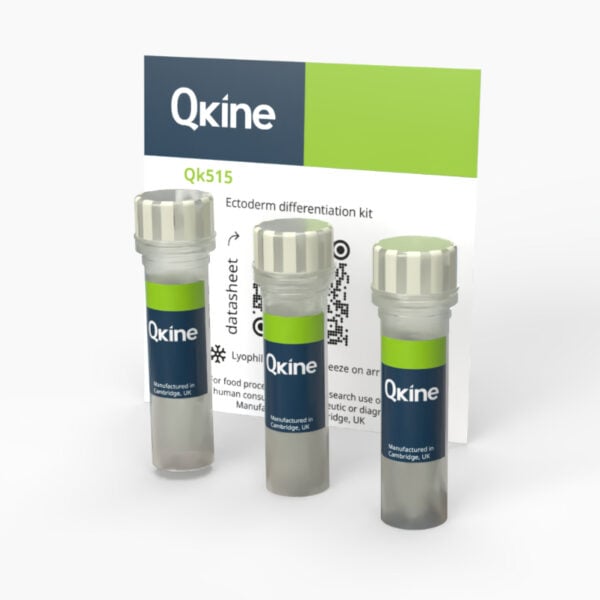Ectoderm differentiation kit
QK515
Brand: Qkine
For validating the ability of induced pluripotent stem cell (iPSC) lines to differentiate into the ectoderm lineage.
The ectoderm differentiation kit is designed to validate the differentiation potential of both newly derived and established iPSC lines. This kit enables the evaluation of the ability of iPSCs to differentiate into the ectoderm linage, one of the three primary germ layers responsible for giving rise to the nervous system, skin, and sensory organs.
The kit includes carefully optimized growth factors and extracellular matrix required to efficiently guide iPSCs toward the ectoderm lineage. It serves as both an endpoint assay, confirming pluripotency and lineage commitment, and a platform for generating ectoderm-derived cells for further downstream applications.
Each kit is sufficient for differentiation of 8x 96 well plates.

Currency:
| Product name | Catalog number | Pack size | Price | Price (USD) | Price (GBP) | Price (EUR) |
|---|---|---|---|---|---|---|
| Ectoderm differentiation kit | QK515 | 1 kit | (select above) | $ 395.00 | £ 305.00 | € 356.00 |
Note: prices shown do not include shipping and handling charges.
Qkine company name and logo are the property of Qkine Ltd. UK.
Summary
- >98%, by SDS-PAGE quantitative densitometry
- Animal origin-free (AOF) and carrier protein-free
- Expressed in E. coli
- Bioactivity Guaranteed
- Manufactured in Qkine's Cambridge, UK laboratories
- Lyophilized
- See reconstitution instructions for individual kit components
Further quality assays
- Mass spectrometry: single species with expected mass
- Recovery from stock vial: >95%
- Endotoxin: <0.005 EU/μg protein (below level of detection)
Featured applications
- Differentiation of iPSC into ectoderm
Kit constituents
- Human noggin – Qk034 – 25 µg
Noggin is used in the culture of intestinal, pancreatic, lung and tumor-derived organoids and the maintenance of undifferentiated embryonic stem cells (ESC) and for stem cell differentiation into neural and microglial lineages. - Human FGF2-G3 (154 aa) – Qk053 – 50 µg
A thermostable engineered form of human FGF-2. Human FGF2-G3 154 aa is the 154 aa mature domain of FGF-2. The functional half-life has increased from <10 h (wild-type) to >7 days (FGF2-G3). - Human vitronectin – Qk120 – 500 µg
Provides a defined environment that supports the maintenance of pluripotency and is suitable for feeder-free culture, expansion, differentiation, and reprogramming of stem cells.
Protein background
Human induced pluripotent stem cells (iPSCs) are an in vitro model that represent a pivotal breakthrough in regenerative medicine and cellular biology. iPSCs are generated by reprogramming adult somatic cells to a pluripotent state through the introduction of specific transcription factors. Reprogramming iPSCs grants these cells the ability to differentiate into any cell type of the three germ layers: ectoderm, mesoderm, and endoderm. This provides unparalleled potential for disease modeling, drug discovery, and cell-based therapies, all without the ethical concerns associated with using embryonic stem cells [1].
Differentiating iPSCs into ectoderm lineage is particularly significant, given the ectoderm’s role in generating the central and peripheral nervous systems, sensory organs, and skin [2]. Differentiating iPSCs into neuroectodermal cells, followed by further differentiating into ectodermal lineages, is critical for studying neurodevelopmental processes, modeling neurological disorders, and developing potential therapies for conditions impacting the nervous system and skin.
The differentiation of iPSCs into neuroectodermal cells typically involves mimicking the stages of embryonic development in vitro. During early embryogenesis, the formation of neuroectoderm is initiated by inhibiting several signaling pathways, such as the TGF-β pathway using small molecule inhibitors like SB431542, and the bone morphogenetic protein (BMP) pathway using BMP inhibitors like noggin, which mimics the natural inhibition of BMPs that occurs during neural plate formation [3].
The successful differentiation of iPSCs into neuroectodermal cells is not without challenges. Due to variability within iPSC lines, differentiation efficiencies, and the potential for incomplete or mixed lineage differentiation are significant hurdles that researchers continue to address. The success can be evaluated by investigating the expression of markers such as SRY-box transcription factor 1 (SOX1) and SRY-box transcription factor 2 (SOX2) [4].
Background references
- Varum, S. et al. Energy Metabolism in Human pluripotent stem cells and their differentiated counterparts. PLoS ONE. 2011;6(6):e20914. doi: 10.1371/journal.pone.0020914
- Tchieu, J. et al. A Modular Platform for Differentiation of Human PSCs into All Major Ectodermal Lineages. Cell Stem Cell. 2017 Sep 7;21(3):399-410.e7. doi: 10.1016/j.stem.2017.08.015
- Smith, J. R. et al. Inhibition of Activin/Nodal signaling promotes specification of human embryonic stem cells into neuroectoderm. Developmental Biology. 2008 Jan 1;313(1):107-17. doi: 10.1016/j.ydbio.2007.10.003
- Galiakberova, A. A. et al. Neural Stem Cells and Methods for Their Generation From Induced Pluripotent Stem Cells in vitro. Frontiers in cell and developmental biology. 2020 Oct 8:8:815. doi: 10.3389/fcell.2020.00815